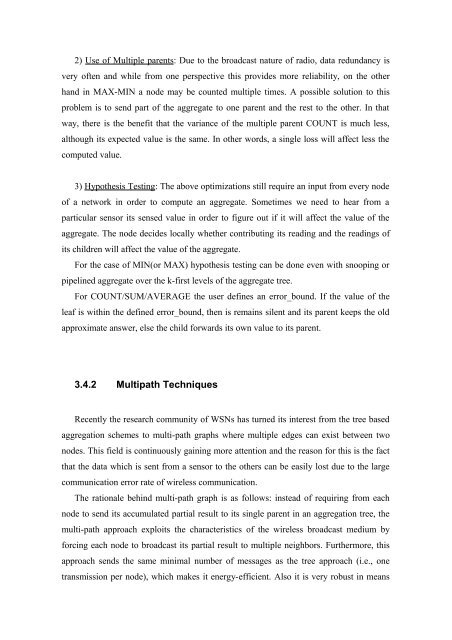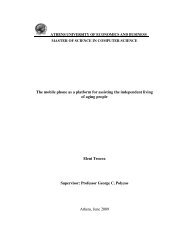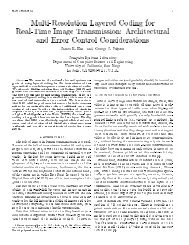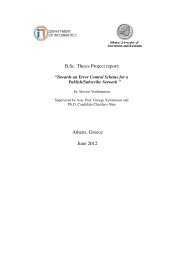In Network Processing and Data Aggregation in
In Network Processing and Data Aggregation in
In Network Processing and Data Aggregation in
You also want an ePaper? Increase the reach of your titles
YUMPU automatically turns print PDFs into web optimized ePapers that Google loves.
2) Use of Multiple parents: Due to the broadcast nature of radio, data redundancy isvery often <strong>and</strong> while from one perspective this provides more reliability, on the otherh<strong>and</strong> <strong>in</strong> MAX-MIN a node may be counted multiple times. A possible solution to thisproblem is to send part of the aggregate to one parent <strong>and</strong> the rest to the other. <strong>In</strong> thatway, there is the benefit that the variance of the multiple parent COUNT is much less,although its expected value is the same. <strong>In</strong> other words, a s<strong>in</strong>gle loss will affect less thecomputed value.3) Hypothesis Test<strong>in</strong>g: The above optimizations still require an <strong>in</strong>put from every nodeof a network <strong>in</strong> order to compute an aggregate. Sometimes we need to hear from aparticular sensor its sensed value <strong>in</strong> order to figure out if it will affect the value of theaggregate. The node decides locally whether contribut<strong>in</strong>g its read<strong>in</strong>g <strong>and</strong> the read<strong>in</strong>gs ofits children will affect the value of the aggregate.For the case of MIN(or MAX) hypothesis test<strong>in</strong>g can be done even with snoop<strong>in</strong>g orpipel<strong>in</strong>ed aggregate over the k-first levels of the aggregate tree.For COUNT/SUM/AVERAGE the user def<strong>in</strong>es an error_bound. If the value of theleaf is with<strong>in</strong> the def<strong>in</strong>ed error_bound, then is rema<strong>in</strong>s silent <strong>and</strong> its parent keeps the oldapproximate answer, else the child forwards its own value to its parent.3.4.2 Multipath TechniquesRecently the research community of WSNs has turned its <strong>in</strong>terest from the tree basedaggregation schemes to multi-path graphs where multiple edges can exist between twonodes. This field is cont<strong>in</strong>uously ga<strong>in</strong><strong>in</strong>g more attention <strong>and</strong> the reason for this is the factthat the data which is sent from a sensor to the others can be easily lost due to the largecommunication error rate of wireless communication.The rationale beh<strong>in</strong>d multi-path graph is as follows: <strong>in</strong>stead of requir<strong>in</strong>g from eachnode to send its accumulated partial result to its s<strong>in</strong>gle parent <strong>in</strong> an aggregation tree, themulti-path approach exploits the characteristics of the wireless broadcast medium byforc<strong>in</strong>g each node to broadcast its partial result to multiple neighbors. Furthermore, thisapproach sends the same m<strong>in</strong>imal number of messages as the tree approach (i.e., onetransmission per node), which makes it energy-efficient. Also it is very robust <strong>in</strong> means








